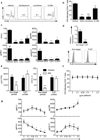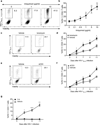TLR7 induces anergy in human CD4(+) T cells
- PMID: 25401424
- PMCID: PMC4413902
- DOI: 10.1038/ni.3036
TLR7 induces anergy in human CD4(+) T cells
Abstract
The recognition of microbial patterns by Toll-like receptors (TLRs) is critical for activation of the innate immune system. Although TLRs are expressed by human CD4(+) T cells, their function is not well understood. Here we found that engagement of TLR7 in CD4(+) T cells induced intracellular calcium flux with activation of an anergic gene-expression program dependent on the transcription factor NFATc2, as well as unresponsiveness of T cells. As chronic infection with RNA viruses such as human immunodeficiency virus type 1 (HIV-1) induces profound dysfunction of CD4(+) T cells, we investigated the role of TLR7-induced anergy in HIV-1 infection. Silencing of TLR7 markedly decreased the frequency of HIV-1-infected CD4(+) T cells and restored the responsiveness of those HIV-1(+) CD4(+) T cells. Our results elucidate a previously unknown function for microbial pattern-recognition receptors in the downregulation of immune responses.
Figures











Comment in
-
A surprising role for TLR7.Nat Immunol. 2015 Jan;16(1):8-9. doi: 10.1038/ni.3051. Nat Immunol. 2015. PMID: 25521672 No abstract available.
Similar articles
-
CD40 ligand trimer and IL-12 enhance peripheral blood mononuclear cells and CD4+ T cell proliferation and production of IFN-gamma in response to p24 antigen in HIV-infected individuals: potential contribution of anergy to HIV-specific unresponsiveness.J Immunol. 2000 Aug 1;165(3):1685-91. doi: 10.4049/jimmunol.165.3.1685. J Immunol. 2000. PMID: 10903780
-
Increased expression of TLR7 in CD8(+) T cells leads to TLR7-mediated activation and accessory cell-dependent IFN-gamma production in HIV type 1 infection.AIDS Res Hum Retroviruses. 2009 Dec;25(12):1287-95. doi: 10.1089/aid.2008.0303. AIDS Res Hum Retroviruses. 2009. PMID: 19954299
-
TLR1/2 Agonist Enhances Reversal of HIV-1 Latency and Promotes NK Cell-Induced Suppression of HIV-1-Infected Autologous CD4+ T Cells.J Virol. 2021 Aug 10;95(17):e0081621. doi: 10.1128/JVI.00816-21. Epub 2021 Aug 10. J Virol. 2021. PMID: 34133900 Free PMC article.
-
A Novel Toll-Like Receptor 9 Agonist, MGN1703, Enhances HIV-1 Transcription and NK Cell-Mediated Inhibition of HIV-1-Infected Autologous CD4+ T Cells.J Virol. 2016 Apr 14;90(9):4441-4453. doi: 10.1128/JVI.00222-16. Print 2016 May. J Virol. 2016. PMID: 26889036 Free PMC article.
-
The inhibitory co-receptors: a way to save from anergy the HIV-specific T cells.Curr HIV Res. 2009 May;7(3):266-72. doi: 10.2174/157016209788347949. Curr HIV Res. 2009. PMID: 19442121 Review.
Cited by
-
Innate Immune Sensing by Cells of the Adaptive Immune System.Front Immunol. 2020 May 29;11:1081. doi: 10.3389/fimmu.2020.01081. eCollection 2020. Front Immunol. 2020. PMID: 32547564 Free PMC article. Review.
-
TREML4 adds fuel to the TLR7 fire.Nat Immunol. 2015 May;16(5):445-6. doi: 10.1038/ni.3149. Nat Immunol. 2015. PMID: 25898191 No abstract available.
-
Identification of Potential Therapeutic Target Genes in Osteoarthritis.Evid Based Complement Alternat Med. 2022 Aug 13;2022:8027987. doi: 10.1155/2022/8027987. eCollection 2022. Evid Based Complement Alternat Med. 2022. PMID: 35996406 Free PMC article.
-
Toll-like Receptor 7 Contributes to Inflammation, Organ Injury, and Mortality in Murine Sepsis.Anesthesiology. 2019 Jul;131(1):105-118. doi: 10.1097/ALN.0000000000002706. Anesthesiology. 2019. PMID: 31045897 Free PMC article.
-
MicroRNA-216a-5p in lipopolysaccharide-induced endothelial injury.Exp Ther Med. 2021 Dec;22(6):1426. doi: 10.3892/etm.2021.10861. Epub 2021 Oct 11. Exp Ther Med. 2021. PMID: 34707707 Free PMC article.
References
-
- Song DH, Lee JO. Sensing of microbial molecular patterns by Toll-like receptors. Immunological reviews. 2012;250(1):216–229. - PubMed
-
- Diebold SS, Kaisho T, Hemmi H, Akira S, Reis e Sousa C. Innate antiviral responses by means of TLR7-mediated recognition of single-stranded RNA. Science. 2004;303(5663):1529–1531. - PubMed
-
- Heil F, Hemmi H, Hochrein H, Ampenberger F, Kirschning C, Akira S, et al. Species-specific recognition of single-stranded RNA via toll-like receptor 7 and 8. Science. 2004;303(5663):1526–1529. - PubMed
-
- Kugelberg E. Innate immunity: Making mice more human the TLR8 way. Nature reviews Immunology. 2014;14(1):6. - PubMed
-
- Kawai T, Akira S. Innate immune recognition of viral infection. Nature immunology. 2006;7(2):131–137. - PubMed
Publication types
MeSH terms
Substances
Grants and funding
LinkOut - more resources
Full Text Sources
Other Literature Sources
Medical
Research Materials

